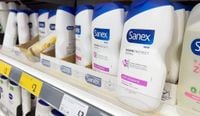In June 2025, a Sanex shower gel television advert hit the UK airwaves, aiming to highlight the brand’s new Skin Therapy range and its purported benefits for dry, itchy, or irritated skin. But what began as a campaign to promote 24-hour hydration soon spiraled into a controversy that would see the advert banned, its creators defending their intentions, and a national conversation ignited about racial representation in advertising.
The advert, produced by Colgate-Palmolive—the company behind the Sanex brand—featured a sequence that, in hindsight, proved problematic. It opened with scenes of two black models: one scratching at her skin, leaving vivid red marks, and another covered in cracked, clay-like material designed to represent dryness and discomfort. The accompanying voiceover intoned, “To those who might scratch day and night. To those whose skin will feel dried out even by water.”
As the advert continued, the narrative shifted. Viewers saw a white woman stepping into a shower, her skin smooth and free of any visible irritation. The voiceover urged, “Try to take a shower with the new Sanex skin therapy and its patented amino acid complex. For 24-hour hydration feel.” The spot concluded with the tagline, “Relief could be as simple as a shower.”
At first glance, the advert’s structure might have seemed like a standard ‘before and after’ demonstration—a common trope in skincare marketing. But two viewers saw something more troubling and filed complaints with the Advertising Standards Authority (ASA), the UK’s advertising watchdog. They argued that the commercial perpetuated the offensive and long-standing stereotype that black skin is “problematic,” while white skin is “superior.”
The ASA launched an investigation and, on August 19, 2025, delivered its verdict: the advert breached broadcast codes and must not be shown again in its current form. According to the ASA’s ruling, “The ad was therefore structured in such a way that it was the black skin, depicted in association with itchy and dry skin, which was shown to be problematic and uncomfortable, whereas the white skin, depicted as smoother and clean after using the product, was shown successfully changed and resolved. We considered that could be interpreted as suggesting that white skin was superior to black skin.”
The watchdog went further, noting, “Although we understood that this message was not the one intended and might appear coincidental or pass unnoticed by some viewers, we considered that the ad was likely to reinforce the negative and offensive racial stereotype that black skin was problematic and that white skin was superior. We concluded that the ad included a racial stereotype and was therefore likely to cause serious offence.”
Colgate-Palmolive, for its part, was quick to defend its creative choices. The company insisted that the use of diverse models was a deliberate attempt to show that Sanex products are suitable for all skin types. In a statement quoted by BBC News, Sanex said, “Our advert was intended to highlight how our Skin Therapy range supports healthy skin across a variety of skin types. At Sanex, our mission is to champion skin health for all, which is portrayed across our brand communications.” The company maintained that the advert was meant to show a “before and after” effect, not to compare skin colours or ethnicities.
Clearcast, the agency responsible for approving or rejecting adverts for television broadcast, also stood by the campaign. According to Sky News, Clearcast argued that the advert “demonstrated the product’s inclusivity” and did not perpetuate negative racial stereotypes. The agency added that the dry and itchy skin on the black models was depicted in a “stylised and unrealistic way,” emphasizing the sensation of discomfort rather than making the skin tone itself the focal point. The model who was shown scratching her skin, Clearcast noted, did so on otherwise healthy-looking skin, with the resulting marks intended to communicate the feeling of itchiness rather than any visible skin disease.
Despite these defenses, the ASA was unmoved. The regulator acknowledged that the problematic message may not have been intentional and could have escaped the notice of some viewers. Nevertheless, it determined that the juxtaposition of black skin in distress and white skin in relief was likely to reinforce negative stereotypes and cause serious offence. The ASA instructed Colgate-Palmolive to “ensure they avoided causing serious offence on the grounds of race” in any future advertising.
The controversy has cast a spotlight on the delicate balance advertisers must strike when representing diversity. While the intention to showcase inclusivity is laudable, execution matters—and even well-meaning campaigns can stumble into harmful territory if they inadvertently echo old prejudices. As Marketing Week reported, the ASA accepted that the advertiser’s intention was not to make comparisons based on race or ethnicity, but stressed that the effect of the campaign was what ultimately counted.
This incident is not occurring in a vacuum. The advertising industry has, in recent years, become increasingly aware of the importance of authentic and sensitive representation. Missteps—especially those involving race—can provoke swift backlash, not just from regulators but from the public and advocacy groups. The Sanex case is a reminder that viewers bring their own histories and experiences to what they see on screen, and that seemingly innocuous creative choices can have unintended consequences.
For Colgate-Palmolive, the fallout is clear: the banned advert cannot be broadcast again, and future campaigns will have to tread carefully to avoid similar pitfalls. The company has not issued a further comment beyond its initial defense, but the ASA’s ruling stands as a warning to the entire sector.
The Sanex advert saga also raises broader questions about the process of vetting adverts before they reach the public. Clearcast’s approval of the campaign, despite its eventual ban, suggests that even established safeguards can miss the mark when it comes to nuanced issues of representation. The ASA’s intervention, prompted by just two complaints, underscores the power of individual voices in shaping industry standards.
Ultimately, this episode serves as a cautionary tale for brands seeking to reflect diversity in their marketing. Good intentions are not always enough; the impact of an advert depends on how it is perceived by those it aims to reach. As the ASA’s ruling makes clear, advertisers must be vigilant to avoid reinforcing harmful stereotypes—no matter how unintentional.
As the dust settles, the Sanex case is likely to be dissected in marketing departments and boardrooms across the country. The lesson is simple, if not always easy to execute: representation matters, but so does the way it is depicted. For now, the advert is off the air, and the conversation about race and advertising continues.






